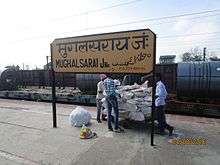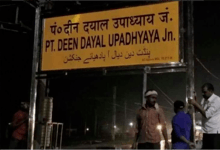Mughalsarai Junction railway station
Mughalsarai Junction | |
|---|---|
| Express Train and Passenger Train Station | |
 Deen Dayal Upadhyaya Junction | |
| Location |
Mughalsarai - 232101, Uttar Pradesh India |
| Coordinates | 25°16′36″N 83°07′02″E / 25.2767°N 83.1173°ECoordinates: 25°16′36″N 83°07′02″E / 25.2767°N 83.1173°E |
| Elevation | 84 metres (276 ft) |
| Owned by | Indian Railways |
| Operated by | ECR |
| Line(s) |
Howrah-Delhi main line Howrah-Gaya-Delhi line Howrah-Allahabad-Mumbai line Gaya-Deen Dayal Upadhyaya Nagar section Deen Dayal Upadhyaya Nagar-Kanpur section Grand Chord Patna- Pt. Deen Dayal Upadhyaya section Pt. Deen Dayal Upadhyaya -Varanasi-Lucknow section |
| Platforms | 8 |
| Construction | |
| Structure type | Standard on ground |
| Parking | Yes |
| Bicycle facilities | No |
| Other information | |
| Status | Functioning |
| Station code | DDU |
| Zone(s) | ECR |
| Division(s) | Mughalsarai |
| History | |
| Opened | 1862 |
| Electrified | 1961-63 |
| Previous names |
Mughal Sarai Junction Eastern Central Railway |
| Location | |
 Pt. Deen Dayal Upadhyay Junction railway station Location in Uttar Pradesh | |
Mughalsarai Jn., officially known as Pt. Deen Dayal Upadhyaya Junction, is a railway station in the Indian state of Uttar Pradesh. It is the fourth busiest railway junction in India. The station contains the largest railway marshaling yard in Asia.[1] Mughalsarai yard cater to around 450-500 trains in a month.[2] All east bound Rajdhani trains halt at this station.
History

The East Indian Railway Company started connecting Delhi and Howrah from the mid nineteenth century. In 1862, the railway tracks crossed Mughalsarai and reached the western bank of the Yamuna.[3] The through link to Delhi was established in 1866.[4] The Grand Chord was commissioned in 1906.[5]
The Dufferin Bridge across the Ganges was opened in 1887, connecting Mughalsarai to Varanasi.[6]
Electrification
The Gaya-Mughalsarai sector was electrified in 1961-63. Mughalsarai yard was electrified in 1963-65.[7]
Marshalling yard
Mughalsarai marshalling yard is the largest in Asia.[8][9][10] It is 12.5 km long and handles around 1,500 wagons daily. Wagon handling has come down after the railways discontinued piecemeal loading. At its peak, it handled 5,000 wagons a day.[8][11]
Sheds and workshops
Mughal Sarai diesel loco shed is home to WDM-2, WDM-3A and WDS-5 diesel locos. There was a Northern Railway diesel loco shed at Mughalsarai. It was decommissioned in 2001. Mughalsarai electric loco shed can hold more than 150 electric locos. Amongst them are WAM-4, WAP-4 and more than 70 WAG-7 locos. Kanpur Central electric loco shed accommodates WAP-4 and WAG-7 electric locos.[12]
The largest wagon repair workshop of Indian Railways is located at Mughalsarai.[12]
Passenger movement
Mughalsarai Junction is amongst the top hundred booking stations of Indian Railways.[13]
Amenities
Mughalsarai Junction railway station has 2 AC rooms, 4 non-AC retiring rooms, and a ten-bedded non-AC dormitory. It has a food plaza and a ‘Jan Aahar’ (affordable food) facility. The station has ATMs of nationalized banks.[14]
Name change
In 1992, the BJP led government of the state of Uttar Pradesh attempted to rename Mughalsarai after Deen Dayal Upadhyaya, a Jan Sangh leader who died there under mysterious circumstances in 1968. However, the plan was shelved when Kalyan Singh, the chief minister was forced to resign after an outbreak of violence in the state following the Babri Masjid demolition.[15] In 2017, the Indian government approved a fresh proposal forwarded by the Yogi Adityanath-led government to rename the station.[16] The station was officially renamed to Pandit Deen Dayal Upadhyaya junction in August 2018.[17]

References
- ↑ http://www.irfca.org/faq/faq-yard.html
- ↑ "Railways to invest Rs3,000 crore to mechanize, automate yards".
- ↑ "The many names of Mughalsarai".
- ↑ "IR History: Early History (1832-1869)". IRFCA. Retrieved 19 June 2013.
- ↑ "IR History: Part III (1900-1947)". IRFCA. Retrieved 19 June 2013.
- ↑ "IR History: Part II (1870-1899)". IRFCA. Retrieved 19 June 2013.
- ↑ "History of Electrification". IRFCA. Retrieved 19 June 2013.
- 1 2 "Freight Sheds and Mashalling Yards". IRFCA. Retrieved 19 June 2013.
- ↑ "General Information" (PDF). East Central Railway. Retrieved 19 June 2013.
- ↑ "Mughalsarai: Tracks to Nowhere". Outlook India, 8 January 2001. Retrieved 19 June 2013.
- ↑ "Marshalling Yards". Indian Railway Employee. Retrieved 19 June 2013.
- 1 2 "Sheds and workshops". IRFCA. Retrieved 19 June 2013.
- ↑ "Indian Railways Passenger Reservation Enquiry". Availability in trains for Top 100 Booking Stations of Indian Railways. IRFCA. Archived from the original on 10 May 2014. Retrieved 19 June 2013.
- ↑ "Mughalsarai Division, Commercial Department" (PDF). Indian Railways. Retrieved 19 June 2013.
- ↑ "Mughalsarai station is now Deen Dayal Upadhyay station". India Today. 5 August 2018. Retrieved 21 August 2018.
- ↑ "Mughalsarai railway station renamed after Deen Dayal Upadhyaya: A look at stations that have been renamed recently". The Indian Express. 4 August 2017. Retrieved 21 August 2018.
- ↑ "Mughalsarai station is now Deen Dayal Upadhyay station". India Today. Retrieved 21 August 2018.
External links
- Mughalsarai Junction railway station at the India Rail Info
| Preceding station | Indian Railway | Following station | ||
|---|---|---|---|---|
Kuchman | East Central Railway zone | Jeonathpur |
||
Ganjkhwaja | East Central Railway zone Grand chord line | Jeonathpur |
||
| Terminus | East Central Railway zone Mughalsarai-Varanasi-Lucknow line |